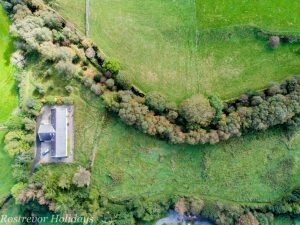5 Historical Sites to Visit when staying at Rostrevor Holidays
All within 30 minutes drive from Rostrevor Holidays:
- Silent Valley and The Mourne Wall
- Ross’s Monument
- Old Kilbroney Graveyard
- Carlingford Village
- Bagenal’s Castle
Silent Valley and The Mourne Wall
“The Silent Valley Reservoir was built to gather water from the Mourne Mountains and is the main water supply source for most of County Down and a large part of Belfast.
Ringed by mountains, ‘The Valley’, located within the Mourne Area of Outstanding Natural Beauty, houses beautiful parkland, lakes and a pond. It attracts around 50,000 visitors per year most of whom come to enjoy the peace and solitude of this mountain area with its unique landscapes and varied wildlife.
The famous Mourne Wall was constructed to enclose the reservoir’s catchment area, built between 1904 and 1922 by the Belfast Water Commissioners.
The wall was crafted from natural granite stone using traditional dry stone walling techniques. On average the wall is about 1.5 metres high and 0.8 to 0.9 metres thick. It is 22 miles (35 km) long and passes over fifteen of the Mourne’s summits.”
Taken from Discover Northern Ireland’s website http://www.discovernorthernireland.com/The-Silent-Valley-and-Mourne-Wall-Kilkeel-Newry-P16373
Ross’ Monument
At the edge of the village on the road to Warrenpoint stands Ross’s Monument, a towering structure built in 1826 to commemorate the military exploits of local man Major General Robert Ross in Europe and the American War of Independence. In particular it celebrates his victory over the American forces at Bladensburg in 1814 and his entry into Washington on the same day. He is reputed to have burnt down the White House. Ross was fatally wounded at the Battle of Baltimore a short time later. Gerard Fay, a Rostrevor architect, travelled to Bladensburg to do some research on the incident, and to his surprise found a monument built over there, dedicated to the two soldiers that shot Major General Robert Ross!
Old Kilbroney Graveyard
Nearby Kilbroney graveyard on the Hilltown Road is especially interesting. Here may be seen the ruins of the church of St. Bronagh dating from the 15th century. Close at hand stands a huge pre-Norman granite cross.. Here too is the grave of Giant Murphy, a local man who was reputed to have been over 8ft. in height. He travelled the world displaying his enormous frame and came back to die and be buried in Rostrevor. The graveyard is also the site of the recovery of an ancient St. Bronagh’s Bell, lost for centuries and probably connected with the ancient church of St. Bronagh.
A strange story attaches to the bell. It is a genuine example of the earliest Christian bells known in Ireland and was the gift of Fergus, a young chieftain. The bell had been hung in the fork of a young oak tree near the convent. The convent was subsequently destroyed but the bell remained hidden. For several centuries it was heard to toll through the valley on certain nights and this was explained by many stories of banshees and leprechuans. Then it became silent.
In 1888 a giant oak fell in Kilbroney churchyard and when it was cut up the bell was found in the hollow trunk. It has been restored and is in use as an altar bell in Rostrevor Catholic Church. Some antiquarians declare its value to be priceless.
Carlingford Village
Carlingford is a magical village, full of character and is one of the best preserved medieval villages in Ireland. Raided by the Vikings in the 8th & 9th Centuries, historical records show that the Vikings occupied Carlingford Lough. They may have used the sheltered harbour as a temporary base, though, this is unclear as no factual evidence, apart from the name Carlingford has been recorded.
Taken from www.Carlingford.ie
Bagenal’s Castle
Rediscovered in 1996, Bagenal’s Castle survived enveloped in the premises of the former McCann’s Bakery on Abbey Way.
The building is of significant historical interest as original plans and elevations of the building still survive in the National Archives of the United Kingdom. It was also built in the environs of the site of the Newry Cistercian Abbey founded in the 12th Century. It has been restored and developed as a Museum and Tourist Information Centre
http://www.discovernorthernireland.com/Bagenals-Castle-and-Newry-and-Mourne-Museum-Newry-P1108



